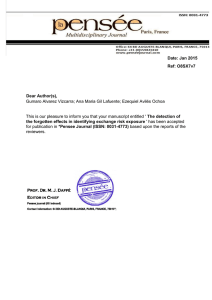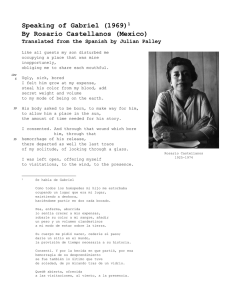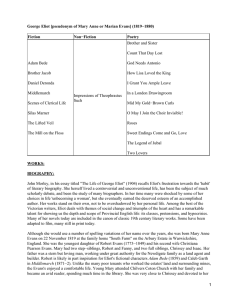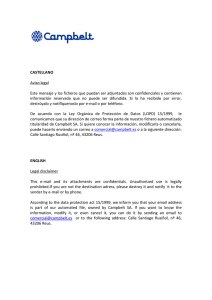INTERTEXTUAL RELATIONS BETWEEN ZI1¿ LOVE SONG OF J
Anuncio
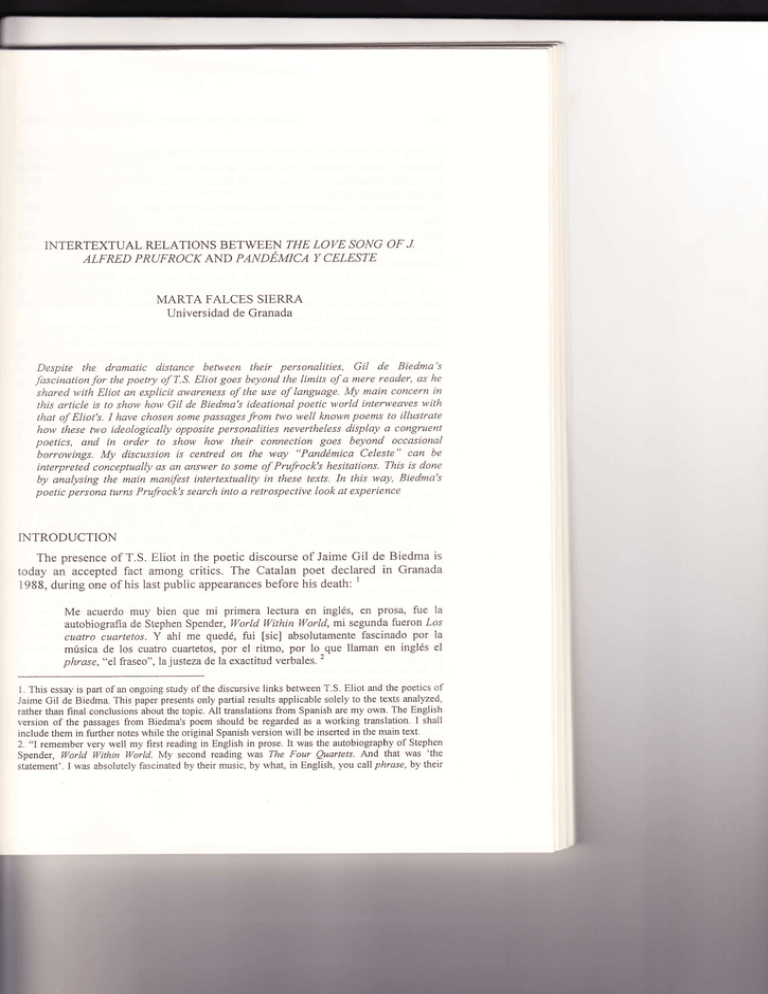
INTERTEXTUAL RELATIONS BETWEEN ZI1¿ LOVE SONG OF
J,
ALFRED PRUFROCK AND PANDÉMICA Y CELESTE
MARTA FALCES SIERRA
Universidad de Granada
Despite the dramatíc dístance between their personalities, Gil de Biedma's
fascínationfor the poetry of T.S. Eliot goes beyond the limils of a mere reader, as he
shared wilh Eliot an explícit awareness of the use of language. My main concern in
this article ¡s to show how Gil de Bíedma's ideational poetic world interweaves with
that of Elíot's. I have chosen some passages from tvvo well known poems to illustrate
how these two ídeologically opposite personalities neveltheless display a congruent
poetics, and in order to show how theír connectíon goes beyond occasional
borrowings. My discussion is centred on fhe way "Pandémica Celeste" can be
interpreted conceptually as an answer to some of Pntfrock's hesitations. This is done
by analysing the main manífest intertextualíty in these texts. In this way, Biedma's
poetic persona turns Prufrock's search into a retrospective look at experience
INTRODUCTION
The presence of T.S. Eliot inthe poetic discourse of Jaime Gil de Biedma is
today an accepted fact among critics. The Catalan poet declared in Granada
1988, during one ofhis iast public appearances before his death:
'
Me acuerdo muy bien que mi primera lectura en inglés, en prosa, fue la
autobiografla de Stephen Spender, World Withín lr/orld, mi segunda fueron los
cuatro cuartetos. Y ahí me quedé, fui [sic] absolutamente fascinado por la
música de los cuatro cuartetos, por el ritmo, por lo que llaman en inglés el
2
phrase,"el fraseo", lajusteza de la exactitud verbales.
L This essay is part ofan ongoing study ofthe discursive links between T.S. Eliot and the poetics of
Jaime Gil de Biedma. This paper presents only partial results applicable solely to the texts malyzed,
rather than final conclusions about the topic, All translations from Spanish are my own. The English
version of the passages from Biedma's poem should be regarded as a working translation. I shall
include them in further notes while the original Spanish version will be inserted in the main text.
2. "l remember very well my first reading in English in prose- It was the autobiography of Stephen
Spender, Wortd ll/ithin llorld. My second reading was The Fout Quartets. A-nd that was 'the
statement'. I was absolutely fascinated by their music, by what, in English, you call phrase,by their
lF--
MARTA FALCES SIERRA
476
Yet,anddespitethisrecognizedinfluence,GildeBiedma'spoeticproduction
anything
has not been iufficiently Jxplored in this way. There is hardly
Eiiot
between
points"
"meeting
concrete
fublished about specifi. po.,,-'r, about
and the Spanish Poet.
(1888-
There-is a diamatic distance between their personalities. T'S' Eliot
introspective poet;
1965) was known as an urban, conservative, religious and
poets of what
lamá Cit de Biedma (Ig2g-lgg0) is one of the most outstanding
is also urban, but in
has been termed as La Escuela de Barcelono; 'his discourse
contrast to that of Eliot is provocative, and politically committed'
JaimeGi]deBiedma*u',u'T.s.Eliotwastoo,inlovewithlanguageasa
exercises in
craft. His poems are, among many other things, exquisite formal
elaborated
an
parl
of
become
emotions
which his Lxperiences, his ráadings and
linguistic structure. In hís own words:
Acasoelalltoropereapartirdepersonalesemocionesyexperienciassuyas,ode
se organiza de
formalizaciones temáticas y conieptuales, pero todo ese material
por
m^odificado
y
decisivamente
es
instantáneas,
manera imprevista, según ieyes
y
función de la
poesía
la
de
(Función
y
fo'males
tinluiti.o'
los elementos
a
crítica, por f.S. Eiiot, en Gii de Biedma 1980:27)
T'hisisthereasonwhy,lbelieve,thekeythatledBiedmatoappreciateE'liot
we should look for
is not to be found in their"personalities as individuals. Rather,
itintheirattitudetolanguage.Theyshareasimilarintensefascinationfor
;.spe."h itself': for language ai a crafl, for its.verbal exactitude, for its grammar,
5
lecture in 1988:
for poetry as an arletací. Bledma said about Eliot in that same
en ese mundo'
No cabe duda que es dificil para un lector contemporáneo entrar
problema que
un
menos'
lo
por
Plantea,
hace
nos
Eliot
q,,e
inuitu.ián
.n
Yo no soy
"ru
po, io -.no, .n *i .uro a veces se resuelve satisfactoriamente
dificultad
jamás
encontrado
he
pero
siquiera,
anglo-católico, ni soy católico
6
poético
goce
y
ei
enire la descreencia
from an amateur recording
precisron and verbal exactitude". This quotation is taken
of the
1988
closingstatementofacoltrseaboutEliotorganizedbytbeAuladePoesíaoftheUniversityof
spoke about their experience as readers'
Granada. In it, Jaime Gil de Biedma ancl Aléx Susanna
Sparrish'
trunrlutoru and edirors ofEliot's poetry lnto Catalan and
3'SeeC'Riera'LaherenciadelaEscueladeBarcelona.Cervanles'2,Marzo2002'en
<http ://artesplasticas. cervanles es/PdlRev ista/EscuelaB arcelona pdt)
.,Maybe the author
.*otion, or from his own experiences, or from thematic and
fi;;;;;ut
4.
""r,
in an unpredictable way' accolding to
conceptual formalizations; howeve¡, all that material is organized
(Gil de Biedma' 1980 21)'
elements."
linguistic
and
formal
by
modiied
is
hnally
it
instant laws. Then.
5. See note 2.
to penetrate in_Eliot's world' to
,.11
is obvious that it is difficult for lhe contempofaneous reader
6.
problenr, that-at times, I have managed to
a
at
least,
means,
lt
uS.
offers
Eliot
invitation
accept that
i ever found the slightest conflict betseen
,oWá, I u¡1 not Anglo-Catholir, not even a Catholic. but
agnosticism and thejoys ofpoetry"
INTERTEXTUAL RELATIONS. T.S.ELIOT AND GIL DE BIEDMA
477
There is a second "intellectual rink" between Eliot and Biedma: thei¡ work
as
is familiar with Eliot's awareness of language
fransmitted through his essays on the craft of poetry. Likewise, Gil
de Biedmá, n-ot
only shared with Eliot an explicit awareness olhir ur. of langúage (the
essays of
iiterary critics. Everybody
-
his Diario de un Artista seriamente Enfermo (Diary oy o ,nrlourly iil-artist);
At pie
de la letra (Literally). In this last one, he centres the discussion in the dichotomy
between poetry as knowledge and poetry as communication in a paper about
Eliot's
ideas from selected Essays. Also, he published, for instance, the catalan
edition of
the Four Quarters, for which he wrote an extensive introduction about
the poems.
LITERATURE REVIEW
Yet, despite this recognized influence, Gil de Biedma's poetic production has
not been sufficiently explored. There are few pieces of'research specífically
about textual influence of Eliot in Biedma,s poetry.
In 1986, Litoral publíshed a monograph edited by García Montero, Jiménez
Millán and A. Salvador: Jaime Gir de Biedma, er juego de hacer versos. Among
others, the essays of Juan Goytisolo, Richard sanger or García Montero contain
specific references to Biedma's connection with Eliot. García Montero proposes
different devices Biedma uses in order to transform poetry into a ,reading
activity':
1.
Quoting a classical author at the beginning of the poem as a leit-motive; z. qu-oting
another poet colloquially, rather than as an exercise of erudition; 3. omitting proper
nouns and inserting other words as part of his own discotrse (As he does with John
Donne's lines in 'Pandémica y celeste'). 4. Finally, Biedma also quotes himself.
ln 1996, Sabadell Nieto published an inreresting piece of reiearch specifically
about the textual influence of Eliot in Biedma's poetry: ,La influencia de T. S.
Eliot
en la poesía de Jaime Gil de Biedma: Tradición como ruptura.'This author
describes several elements which, in her view, justify the above-mentioned relatio¡
between both poets: namely, the imitation of some poetic forms,
- and more
specifically their use
of
dramatic monologue, the imitation
of
images, the
occasional borrowing of words found in Biedma's lines, the developtent
some Eliotian "themes", and frnally, the critical proximify between them,
shown in the quotation below:
Hay alusiones mínimas, como la imitación de una forma poética o
ol
as
algún
préstamo de palabras o de versos aislados, (...) imitación de algunas irnágeñes.
el desarrollo de ciertos temas, la adaptación y el uso de conceptos teóricos
elotianos en algunos poemas específicos, y, finalmente, queda por indica¡ la
proximidad de la labor crítica. (Sabadell Niero 1996:75)
Hers is a good approximation. However, the connection between these poets
is not, in my view, as casual as Sabadell Nieto suggests. There is some proximity
between both poetic discourses which her paper misses: despite Biedma's
contrary view of reality (ideology) to that of Eliot, their world viervs are woven
together by their close poetic discourse.
418
MARTA FALCES SIERRA
Finally, it is worth mentioning the most recent publication on Ihe topic, Jaime
Git de Biednta y la tradición angloamericana, by A.S. Walsh (2004). This
outstanding piece of research plunges into the seas of Eliotian critical ideas and
their influence in the poetics of Biedma withrn the realm of Comparative literature
and Critical theory. Yet, the purpose of this study goes beyond the aims of this paper.
In my view, if the attraction that somebody like Gil de Biedma felt for Eliot
rests on the formation of his poetics, it is in the study of Biedma's poetic
discourse that we should seek evidence
olthis fascination.
HYPOTHESiS
My main concern in this paper is to demonstrate how Gil de Biedma's
ideational poetic world interweaves with that of Eliot. I have chosen some
passages Íiom two well known poens to illustrate how these two ideologically
opposite personalities neverlheless display a congruent poetics, and in order to
show horv their connection goes beyond occasional borrowings. Specifically, I
shall examine the intertextual relations between the language of the well known
,Love Song of J. Alfred Prufrock' (191O/pub.1915) and 'Pandémica y celeste'
(1964165), a poem included in Gil de Biedma's main volume Las personas del
verbo (All the Persons ofthe Verb).
The key concepts that I have chosen as the bases fbr the analysis are:
A. The notion of intertextuality,
texfs hqve
as proposed
by Fairclough'. "the properly
of being frll of snatches of other texts, which may
be
expticitly demarcated or merged in, in which the text may o"ssimilate,
contradict, ironically echo, and soforth". (Fatrclough 1992:84)
B. The ideational function of language as Halliday defines it'. "The way
the speaker embodies in language his experience of the real world,
and this includes his experience of the ínternal world of his own
cons
ciousness" (Halliday 191 1:333)
centred on the rvay 'Pandémica y Celeste' can be
interpreted conceptuall,v as an answer to some of Pruffock's hesitations. This ls
?
done by analyzing the main manifest interfextuality in these texts. tn this rvay,
My
discussion
is
Biedma's poetic persona turns Prufrock's search into a retrospective look at experience
7. For an exrended discussion of intertextuality see Fairclough (1992:85). Here, the autho¡ defines
*
mani;fest ¡ntertextudli+) as: 'texts seen historically as transforming the past existing conventions a¡d
prior texts - into the present'.
INTERTEXTUAL RELATIONS: T.S,ELIOT AND GIL DE
BIEDMA
47g
ANALYSIS AND DISCUSSION
GASE 1: The first evidence can be found in the opening lines of both poems.
(A) Let us go then, you and
u
I
when the eveníng is spread out against the sky,
like a patient etherised upon a table;
Let us go, through certain-halfdeserted streets,
The muttering retrectts
Ofrestless nights in one night cheap hotels
and sawdust restaurants with oyster-shells:
Streets that follow like a tedious argument
of insidious intent
To lead you to an overwhelmíng question...
Oh, do not ask, 'What ís ít?'
Lef us go and make our visit. (emphasis added)
(B) e Imagínate ahora que tú y yo
muy tarde ya en la noche
hablemos finalmente de hombre a hombre.
Imagínetelo,
en una de esas noches memorables
de rara comunión, con la botella
medio vacía, los ceniceros sucios,
y después de haber agotado el tema de la vida.
Que te voy a enseñar un corazón,
un corazón infiel,
desnudo de cintura para abajo,
hipócrita lector - mon semblable, - mon frérel
10
(emphasis added)
By bonowing some literal ex?ressions, Biedma appropriates prufrock's invitation, but
he changes the perspective by changing the verbal processes and role ofparlicipants:
A. Prufrock is looking for some inexplicit participant (expressed by a
material process (Let us go - material process/intransitive relation). He
for a search. Biedma's poetic persona offers an
invitation for reflection. He proposes a mental process of knowledge in
order to examine experience; Prufrock's invitation leads nowhere,
expresses an invitation
"because [he] does not dare", as we all know fiom line
3j
on in the poem.
8. Italicized passages are used to indicate foregrounded parts to be commented on in the analysis.
Now imagine that you and
Already lale at night Finatty talk man-to-man.
Just imagine.
¡' In one of those memorable nights ,z Of rare communion, by a half-empty ,z Bottle, by dirty
9.
I/
/
/
/ Andafler havingexhaustedthemeaningoflife. / Forlamgoingtoshowyoua
/ A¡ unfaithful heart, / Naked from the rvaist down / Hypocritical reader - mon
ashtrays,
hearf,
se mb lab le, mon frére ! (emphasis added).
10. It is wor¡h pointing out the presence ofBaudelaire's line here, which
another of his poems.
11l
Eliot also borrowed in
INTERTEXTIJAL RELAT]ONS,
T.S.ELIOT AND GIL DE B1EDMA
Here, the location
of
prufrock's invitation
481
is
manifestly borrowed and
recontextuarized again by Biedma.
In this passage, Biedma,s persona chooses
one of the circumstances in pruffock's
invitation (placeidirectioiai adjunct), .ret
us go, through half deserted streets,
the muttering ietreats orr.rii"r, nights...,
as
the central location of his experien;"
aCI;;o"hei en hotele, a" *u noche,). Nor
only the time perspective changes uut'ui*
iie location to. *rr.r.
is
defined: Prufrock's local circrimrtunr.
"xperience
in hi, ,"u."h is used in ,pandémica
y
celeste' as the ob-rect affected by the
mental p.o."r, (the act of remembering) in
-iri,
order to define his experience:
,""rut
These lines arso take the
reader back to prufrock's doubts
"^perience.
in lines voúl¿
it have u."n *ortl, it, after alr?,
(87-90;100, 106).
Such memories
in 'pandémica'
are preceded by the statement in lines 24-2g,
ín which we read an aliusion to Johr
bonn.', poem 'The Ecstasy, et.7r-72),
connected with the idea of 'the
body as a means of purification,. Biedma
writes:
Para saber de amor, para aprenderle
Haber estado solo es necesario
Y es necesario en cuatrocientas noches
- con cuatrocientos
cuerpos diferentes _
haber heoho el amor.
eue sus ntísterios.
cono dyo el poeto. son del almct,
pero un cuerpo es el libro en el que
se leen. (emphasis addecl)
cASE III: The third
passage I have serected takes
us to the end
Celeste'. At this poinr we read:
Sobre su piel borrosa,
c.uando pasen más años y
al
of ,pandémica y
final estemos
Quiero aplastar los labios invocando
la imagen de su cuerpo
y de todos los cuerpos que una vez
amé_
aunque fuese un instante, deshechos
por el tiempo.
para pedir la fuerza de poder vivir
sin belleza. sin fuerza y sin deseo.
mienlras seguimos.juntos
hasta mo¡ir en paz, los clos,
como dicen que mueren los que han
amado mucho.
As the poem closes, the poetic persona
in 'pandémica y celeste, once more
interweaves with pruÍiock uy o*oiting
,ir."uugu. and doubtful commitment he
makes in line 80; "shorlcr I'have the
trTrngrn toforce rhe moment ro its crisis?,,
"modality).
(reJational possessive Drocess;
epistemic
In ,pandémica v celeste,
lhis question becomes a sffong wiih
f,or rear rove. for ererniry and for -i"lr,::tü:
Prufrock's
epistemic 'should"'
u."o-.r-l ion mo¿atir"á ,I
aplastar para pedir') after the experience.
want, (,quiero
MARTA FALCES SIE3..
(you/i)' The '1ou '
B. Pruffock's proposal invoives only two participarfs
p'liot
have acknou'ledg'to
is
said
ai
probably urrlut. companion,
poetic persona ::Biedma's
For
this'
for
However. I have no
::';
"uid"ntt
pio..r, á*punds to a third participant affected by the action of
process, 'lmagínate... que te vtv a enseñar un corlzó1,.i1fi:]'.9::llt-:t-discourse)' This is- the polni
[".ritip^*, n"on .tirt"nt in Piuffock's
inhl.t.,'*" know Biedma's poetic persona is looking back"' {ls9' "'
a hombre '
know the addressee is a maie fliend ("de hombre
"talking clear and loud"
.*fr.rrion which also suggests
"tiis
of perspective is . realized :
change
C. Furlher evidence Lor
t1th
circumstantial elements (time adjuncts) Time
.tn.
,'"the sk'v' Biedn:
Prufrock: 'When the evening is ipread out against
changes
persona: 'Mu.v tarde ya en la noche''
'then' (1.1) and Biedi.t.t:,
D. Notice also the paralielism between Prufrock's
,nnutif,
,now, and
(ll. I and 3). Those logical connectors/conjun.'
whichallowustothinkofbothstanzasasonefollowingtheother:fi:'.
the visit, and then' the reflectiolt'
Thismanifestültedextualityoperatesasifthe..visit,,(1'12)thartakesth.
some hours later'late at night' an;
reader to prufrock's search haibeen retaken
lines i'
procedure also operates
exantinecl by Biedma's persona (ie' this
:l::
'que te voy a enseñar un corazón infiel' '
1..d ;;;;";n oue.*h*lming question',
and formal elements sttch as
Finally, notice the otguii'ution of the stanza
in both poems'
una parallel strtttures which are quite close
,.p"tiii-*
CASE2:Laterin'PandémicayCeleste'(lines48-52)aftertherecollectiono;
some of his sexual experiences' we read:
(A') Let as go, through cer-tain-half deserted streets'
The mtttter irLg r eft e ats
OJ restless nights in one night cheap hotels
and salvclust reslaurailts lvith oyster-sheIIs:
Streets that
follou' like a ledious argumoni
of insidious intent
(B) Recuerclos de vosotras, sobre todo'
ah noches en holeles de una noche'
cleJinitiv as noc ltes en pensiones sórdidas'
en cuartos recién fi'íos'
nrtches qtte clet'c¡lveis a vuestros.huéspedes
Ir
un olvidado sabor a sí mismosl
11
'^
hotels' / Defnitive nl¡Jhls in sordrd
all, memortes o;fyou, i Oh nights in one night cheap
/ to a
/
Nights which bring your guests back
rooms
down
coolerl
tn¡ust
f
¡."t¿t"g'ft"ures,
Above
added)
forgotte-n taste of themselves| (ernphasis
MARTA FALCES SIER?.'
482
Here there is no modality, .iust a volitional mental process in present tense, n hi;i
reinforces the poetic persona's will to ask for the strength to live without beaui' strength or desire, through the knowledge and experience that the other's boq'
prouid"r' ('quiero aplastar sus labios invocando...'). If for Prufrock, the possibiliq .:
iorcing a moment leads him nowhere, it becomes just a rhetorical question- ttr
'Pandémica y Celeste' this possibility achieves the ftial love, a relationship based .-the experience that Prufiock lacks and seeks for (knowledge: experience)'
Af the end, while Prufrock finds no redemption, and stays "hearing tlie mermail'
singing, each to each" (1. 124), when he drowns having attained nothing, Biedm¿.
p.rionu furds 'Celeste' by means of the body, the unfaithful love, the forbidden.
FINAL REMARKS
ln general terms, the analysis shows how the ideational world of Pruffock li:.
been actually used in 'Pandémica y Celeste' in order to create a different realiq'
Some processes have been literally transported into Biedma's poem; others har.
been reworked into answers to Prufrock's questions.
This type of analysis does not intend to be global. However,
it provides
r.
explicit account of horv the world of 'Pandémica y celeste' is influenced b-r
Eliot's ideas more than just theoretically. The way reality is porfrayed has bee:
proved to be connected i¡ these two poems. It is their language, their grammar that is
irl¿¿.tr behind the obvious. What really matters here is the way Prufrock's rhetor:¿
(the rhetoric of search) is reformulated il'Pandémica y Celeste' in order to gire a
personai answer to these hesitations by the construction of a different ideatione'
world, and as a consequence, a differentrhetoric (the rhetoric ofexperience):
... One of the surest tests is the way in which a poet borrows. Immature poe:.
imitate; mature poets steall bad poets deface what they take, and good poets ma,::
it into something better, or at least something different. The goodpoetwelds i;..
theft into a whole of feeLing which is uníque, utterly dffirent from thal whicl¡ ':
v)as torn; the bad poet throws it into something which has no cohesion. A goc:
poet will usually borrow form authors remote in time, or alien in language, odiverse in interest. (Eliot 1980:206; emphasis added)
And it is exactly this road down which Biedma traveis.
REFERENCES
Bush, R. i984. ZS. Etiot, A study
University Press.
in Character and style. oxford: oxford
crawford, n. tssz. The savage and the city in the lltork of T
s
Eliot. oxford
Clarendon Press.
Eliot, T.S. 1980. Philip Massinger llg20l,nselected Essays. London: Faber and Faber.
Eliot, T.S. 1974 [1936]. Collected Poeil,s. London: Faber and Faber'
INTERTEXTUAL RELATIONS, T.S.ELIOT
AND CIL DE BIEDMA
483
Fairciough, N. r992. Discourse and
sociar change. cambridge: pority press.
Garc-ía Montero, L., A. Jiménez
Millán unJ e. Salvador (eds.) igg6. Jaime Gir
de Biedma, el jueso de hacer versos.
f4,aSugu, Litoral.
Git de Biedm a, t. íwí. o¡o,i-in ;; ;;;;;';;;,rmente
enJérmo. Barcerona; Lumen.
Gil de Biedma, J' 19g4. prólogo r. s.
eii"t. euatre euartets. Barcerona: Ers
"
libres de glaucos.
Gil de Biedma, J ' r9g2. Las personas der
verbo. Barcelona: Seix Barral.
Gil de Biedm a, J ' 19g0.^'4 / pie de ra tttro.irroyo,
I 95 5-r g7g. Barcerona: crítica.
Halliday, M.A.K. r9g5. An Inrroductin -to
Functionar Grammar. London:
Edward
Arnold.
Halliday, M'A'K. r971. Linguistic structure
and literary style; an inquiry into the
language of william Goiding's rhe
nheliors, in s. chatman (ed). Literary
style A symposium. Londonloxford university press,
332_334.
^
fuera,
C. l9BB. La escuela cle Barcelona. Áu.".tonu,
Anagrama.
Sabadell Nieto, J. 1994.Lainfluencia
o. r. s. eliot
ra poesía de Jaime Gil de Biedma:
como ruptura, in I{.M. Sibbald unO
ff "n
Vo*g (eds).
^ , ,Tr."9bj9l
Sibbald,
K'M and H. Young (eds). 199a. r. nt¡o, and 1994:75_87.
Hispanic Moderniry
.s
(l924-1993l' Boulder (co): sociery
of Spanish and
"
Walsh,
--
Spanish-American Studies.
A. S. 2004. Jaime Gil de'Biiedlma' y la tradición
angloamericana.
Granada:
Universidad de Granada.


